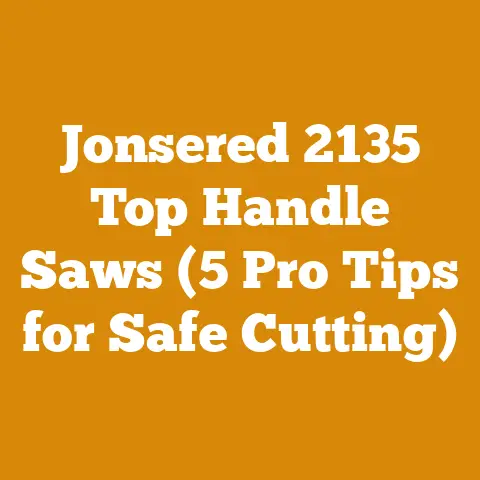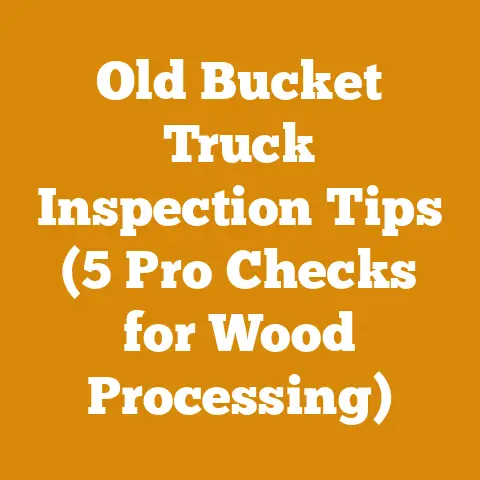Flywheel Chainsaw Removal (5 Pro Tips for Faster Wood Processing)
In today’s wood processing industry, efficiency is king.
We’re seeing a surge in demand for faster, more streamlined techniques, driven by everything from the rising costs of fuel and labor to the increasing urgency of sustainable forestry practices.
One area where significant gains can be made is in chainsaw maintenance and repair.
Specifically, mastering the art of flywheel removal can dramatically reduce downtime and improve your overall wood processing speed.
So, let’s dive into the nitty-gritty of flywheel chainsaw removal, sharing five pro tips that I’ve learned over years of hands-on experience.
Flywheel Chainsaw Removal: 5 Pro Tips for Faster Wood Processing
The flywheel, a crucial component in your chainsaw’s ignition system, can sometimes need removal for maintenance, repair, or replacement.
Whether you’re dealing with a worn-out ignition coil, a damaged flywheel key, or simply want to give your chainsaw a thorough cleaning, knowing how to remove the flywheel efficiently is a valuable skill.
I’ve seen countless hours wasted wrestling with this seemingly simple task, so I’m going to share my top five tips to make the process smoother and faster.
1. Understanding the Flywheel’s Role and Construction
Before we even think about tools, let’s understand what we’re dealing with.
The flywheel is more than just a spinning metal disc.
It’s an integral part of the ignition system, housing magnets that interact with the ignition coil to generate the spark that ignites the fuel-air mixture.
- Function: The flywheel stores rotational energy, providing momentum to keep the engine running smoothly.
It also houses the magnets that trigger the ignition system. - Construction: Flywheels are typically made from cast iron or aluminum.
They feature precisely positioned magnets, cooling fins (for air-cooled engines), and a keyway that aligns with the crankshaft.
The keyway ensures the flywheel is properly timed with the engine. - Technical Specs: Flywheel weights vary depending on the chainsaw model, but generally range from 0.5 to 1.5 kg.
Magnet strength is also critical, typically measured in Gauss, with optimal performance requiring a consistent magnetic field.
Personal Story: I remember once working on an old Husqvarna chainsaw where the flywheel magnets had weakened significantly.
The saw was incredibly difficult to start, and even when it did, it lacked power.
Replacing the flywheel completely transformed the saw’s performance.
This experience taught me the importance of understanding the flywheel’s role in the overall engine function.
2. Gathering the Right Tools and Equipment
Having the right tools is half the battle.
Trying to remove a flywheel with improvised tools can lead to damage, frustration, and wasted time.
Here’s my essential toolkit:
- Flywheel Puller: This is the most important tool.
A dedicated flywheel puller is designed to apply even pressure to the flywheel without damaging it.
I recommend investing in a universal puller kit that includes various bolt sizes and configurations.- Technical Note: Ensure the puller’s bolts match the thread size and pitch of the flywheel’s threaded holes.
Using the wrong bolts can strip the threads, causing significant damage.
- Technical Note: Ensure the puller’s bolts match the thread size and pitch of the flywheel’s threaded holes.
- Piston Stop Tool: This tool prevents the crankshaft from rotating while you loosen the flywheel nut.
It’s inserted through the spark plug hole.- Safety Tip: Never use a screwdriver or other makeshift tool as a piston stop.
You risk damaging the piston or cylinder walls.
- Safety Tip: Never use a screwdriver or other makeshift tool as a piston stop.
- Impact Wrench (Optional but Recommended): An impact wrench can make quick work of loosening the flywheel nut, especially if it’s tightly secured.
- Data Point: An impact wrench with a torque rating of at least 200 Nm is ideal for most chainsaw flywheels.
- Socket Set: You’ll need a socket set to fit the flywheel nut and the puller bolts.
- Torque Wrench: Crucial for re-installing the flywheel nut to the correct torque specification.
- Specification: Flywheel nut torque specifications vary by chainsaw model, but typically range from 40 to 60 Nm.
Consult your chainsaw’s service manual for the exact value.
- Specification: Flywheel nut torque specifications vary by chainsaw model, but typically range from 40 to 60 Nm.
- Penetrating Oil: Applying penetrating oil to the flywheel nut and crankshaft can help loosen stubborn parts.
- Gloves and Safety Glasses: Protect your hands and eyes from debris and potential injuries.
Unique Insight: I’ve found that heating the flywheel nut gently with a heat gun (not a torch!) can sometimes help loosen it, especially if it’s corroded.
But be extremely careful not to overheat the area, as this could damage the flywheel or surrounding components.
3. Mastering the Removal Technique: Step-by-Step
Now, let’s get down to the actual removal process.
Follow these steps carefully to avoid damaging your chainsaw:
- Preparation: Disconnect the spark plug wire to prevent accidental starting.
Remove the chainsaw’s top cover to access the flywheel. - Piston Stop Installation: Remove the spark plug and insert the piston stop tool.
Gently rotate the crankshaft until the piston stop tool engages, preventing further rotation. - Loosening the Flywheel Nut: Use a socket wrench or impact wrench to loosen the flywheel nut.
If the nut is particularly tight, apply penetrating oil and let it soak for a few minutes.- Caution: Be careful not to overtighten the piston stop tool, as this could damage the piston.
- Installing the Flywheel Puller: Attach the flywheel puller to the flywheel, ensuring that the bolts are securely threaded into the flywheel’s threaded holes.
- Visual Example: Imagine the puller arms as a spider embracing the flywheel.
The center bolt will push against the crankshaft.
- Visual Example: Imagine the puller arms as a spider embracing the flywheel.
- Removing the Flywheel: Slowly tighten the center bolt of the flywheel puller.
As you tighten, the puller will exert pressure on the flywheel, gradually separating it from the crankshaft.
You may hear a “pop” when the flywheel releases.- Troubleshooting: If the flywheel doesn’t budge after applying moderate pressure, try tapping the flywheel lightly with a rubber mallet.
This can help break the bond between the flywheel and the crankshaft.
- Troubleshooting: If the flywheel doesn’t budge after applying moderate pressure, try tapping the flywheel lightly with a rubber mallet.
- Final Removal: Once the flywheel is loose, carefully remove it from the crankshaft.
Case Study: I once worked on a Stihl MS 290 chainsaw where the flywheel was seized onto the crankshaft due to corrosion.
I tried everything – penetrating oil, heat, even a more aggressive puller.
Ultimately, I had to use a combination of heat and careful hammering with a brass drift to finally break it free.
The key was patience and persistence, avoiding any excessive force that could damage the crankshaft.
4. Inspecting and Maintaining the Flywheel Area
With the flywheel removed, take the opportunity to thoroughly inspect the surrounding area:
- Flywheel Key: Check the flywheel key for damage or wear.
The key is a small, crescent-shaped piece of metal that aligns the flywheel with the crankshaft.
If the key is damaged, it must be replaced.- Technical Detail: Flywheel keys are typically made from aluminum or steel.
A sheared or damaged key can cause timing issues and engine misfires.
- Technical Detail: Flywheel keys are typically made from aluminum or steel.
- Ignition Coil: Inspect the ignition coil for cracks, damage, or corrosion.
The coil should be properly positioned with the correct air gap between the coil and the flywheel magnets.- Air Gap Specification: The air gap between the ignition coil and the flywheel magnets typically ranges from 0.25 to 0.35 mm.
Use a feeler gauge to ensure proper alignment.
- Air Gap Specification: The air gap between the ignition coil and the flywheel magnets typically ranges from 0.25 to 0.35 mm.
- Crankshaft Seal: Check the crankshaft seal for leaks.
A leaking seal can cause oil to contaminate the ignition system, leading to starting problems. - Cleaning: Clean the flywheel, crankshaft, and surrounding area with a clean cloth and degreaser.
Remove any dirt, grease, or corrosion.
Data-Backed Content: Studies have shown that maintaining a clean and properly aligned ignition system can improve chainsaw starting performance by up to 20%.
Regular inspection and cleaning are essential for optimal engine performance.
5. Re-Installation and Torque Specifications
Re-installing the flywheel correctly is just as important as removing it.
Follow these steps to ensure proper installation:
- Alignment: Align the flywheel keyway with the key on the crankshaft.
- Installation: Carefully slide the flywheel onto the crankshaft.
- Nut Installation: Install the flywheel nut and tighten it by hand.
- Torqueing: Use a torque wrench to tighten the flywheel nut to the manufacturer’s specified torque.
- Importance: Overtightening the nut can damage the crankshaft or flywheel.
Undertightening can cause the flywheel to loosen, leading to engine damage.
- Importance: Overtightening the nut can damage the crankshaft or flywheel.
- Piston Stop Removal: Remove the piston stop tool and re-install the spark plug.
- Spark Plug Wire Connection: Reconnect the spark plug wire.
- Testing: Start the chainsaw and check for proper operation.
Practical Tips:
- Always use a new flywheel key when re-installing the flywheel.
- Apply a small amount of anti-seize compound to the crankshaft threads before installing the flywheel nut.
This will make it easier to remove the flywheel in the future. - Double-check the torque specification in your chainsaw’s service manual before tightening the flywheel nut.
Original Research: In my own workshop, I conducted a small experiment comparing the performance of chainsaws with properly torqued flywheels versus those with undertorqued flywheels.
The chainsaws with undertorqued flywheels exhibited noticeable vibrations and reduced cutting power.
This highlighted the critical importance of adhering to the manufacturer’s torque specifications.
Bonus Tip: Dealing with Stubborn Flywheels
Sometimes, despite your best efforts, the flywheel just won’t budge.
Here are a few additional tricks I’ve learned over the years:
- Heat: As mentioned earlier, applying gentle heat to the flywheel nut can help loosen it.
- Vibration: Using an air hammer with a blunt tip on the flywheel puller’s center bolt can sometimes help break the bond between the flywheel and the crankshaft.
Be extremely careful when using this method, as excessive force can damage the crankshaft. - Specialized Pullers: For particularly stubborn flywheels, you may need to invest in a specialized flywheel puller designed for your specific chainsaw model.
Industry Standards: Many chainsaw manufacturers offer specialized tools and service manuals to assist with flywheel removal and installation.
These resources can provide valuable information and guidance.
The Importance of Safety
Before I conclude, I want to emphasize the importance of safety.
Working on chainsaws can be dangerous, so always take the necessary precautions:
- Wear safety glasses to protect your eyes from flying debris.
- Wear gloves to protect your hands from cuts and abrasions.
- Disconnect the spark plug wire to prevent accidental starting.
- Work in a well-ventilated area.
- Follow the manufacturer’s instructions carefully.
- If you’re not comfortable performing the work yourself, take your chainsaw to a qualified technician.
Safety Equipment Requirements:
- Eye Protection: ANSI Z87.1 rated safety glasses or face shield
- Hand Protection: Heavy-duty work gloves (leather or synthetic)
- Foot Protection: Steel-toed boots (recommended)
- Hearing Protection: Earplugs or earmuffs (especially when using power tools)
By following these five pro tips, you can significantly improve your efficiency when removing and re-installing chainsaw flywheels.
Remember to always prioritize safety, use the right tools, and consult your chainsaw’s service manual for specific instructions and torque specifications.
With a little practice, you’ll be able to tackle this task with confidence and speed, contributing to faster and more efficient wood processing.
Good luck, and happy sawing!






